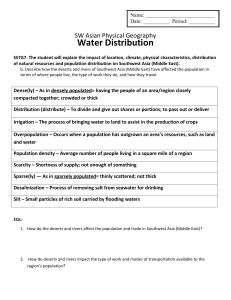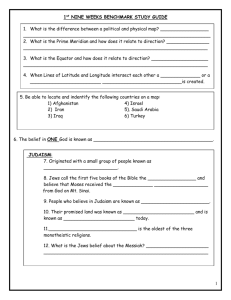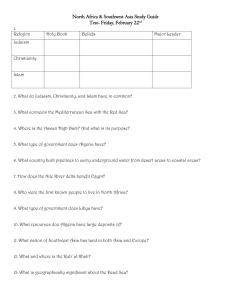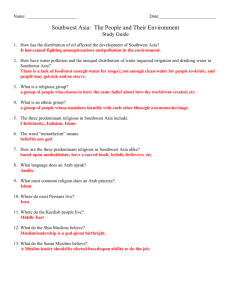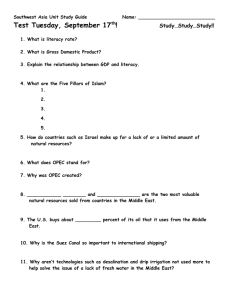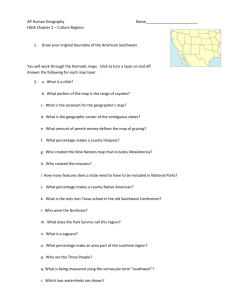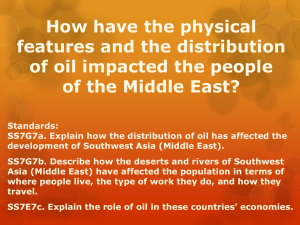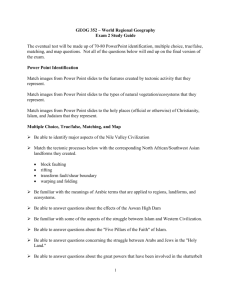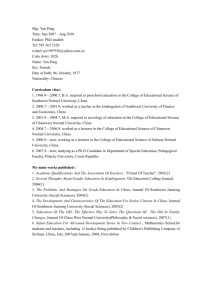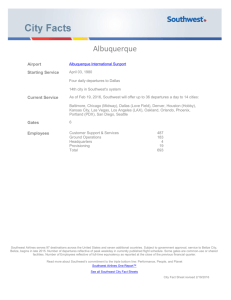1st NINE WEEKS BENCHMARK STUDY GUIDE 1. What is the
advertisement
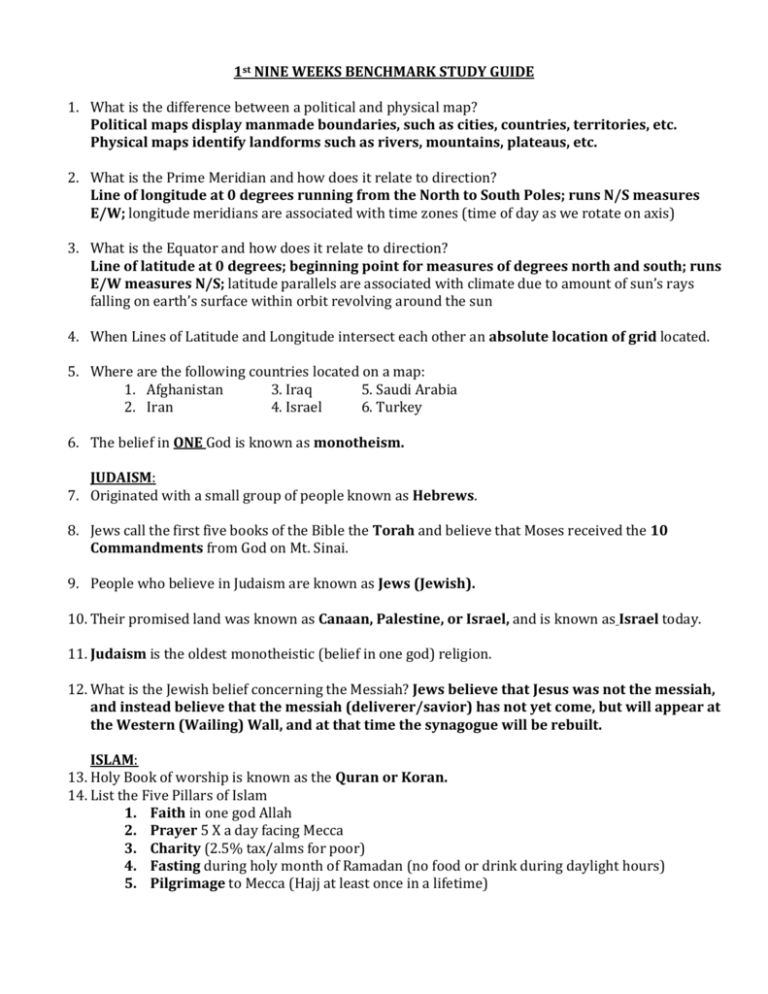
1st NINE WEEKS BENCHMARK STUDY GUIDE 1. What is the difference between a political and physical map? Political maps display manmade boundaries, such as cities, countries, territories, etc. Physical maps identify landforms such as rivers, mountains, plateaus, etc. 2. What is the Prime Meridian and how does it relate to direction? Line of longitude at 0 degrees running from the North to South Poles; runs N/S measures E/W; longitude meridians are associated with time zones (time of day as we rotate on axis) 3. What is the Equator and how does it relate to direction? Line of latitude at 0 degrees; beginning point for measures of degrees north and south; runs E/W measures N/S; latitude parallels are associated with climate due to amount of sun’s rays falling on earth’s surface within orbit revolving around the sun 4. When Lines of Latitude and Longitude intersect each other an absolute location of grid located. 5. Where are the following countries located on a map: 1. Afghanistan 3. Iraq 5. Saudi Arabia 2. Iran 4. Israel 6. Turkey 6. The belief in ONE God is known as monotheism. JUDAISM: 7. Originated with a small group of people known as Hebrews. 8. Jews call the first five books of the Bible the Torah and believe that Moses received the 10 Commandments from God on Mt. Sinai. 9. People who believe in Judaism are known as Jews (Jewish). 10. Their promised land was known as Canaan, Palestine, or Israel, and is known as Israel today. 11. Judaism is the oldest monotheistic (belief in one god) religion. 12. What is the Jewish belief concerning the Messiah? Jews believe that Jesus was not the messiah, and instead believe that the messiah (deliverer/savior) has not yet come, but will appear at the Western (Wailing) Wall, and at that time the synagogue will be rebuilt. ISLAM: 13. Holy Book of worship is known as the Quran or Koran. 14. List the Five Pillars of Islam 1. Faith in one god Allah 2. Prayer 5 X a day facing Mecca 3. Charity (2.5% tax/alms for poor) 4. Fasting during holy month of Ramadan (no food or drink during daylight hours) 5. Pilgrimage to Mecca (Hajj at least once in a lifetime) Islam, Continued… 15. Muhammad believed (and now Muslims believe) that Jesus was a prophet and not the Messiah. 16. Muhammad is the founder of Islam. 17. People who are Islamic in faith are known as Muslims. 18. Islam is the fastest growing religion. 19. What is the basic difference between Sunni and Shi’ite (Shia) Muslims? Sunni members (90%) believe the caliph/imam leader of Islam should be chosen as the best leader for the job; Shi’ite (Shia) (10%) members believe the leader should be a direct descendant of the founder of the Islamic faith, Muhammad (should be from Muhammad’s family) 20. Christianity: 1. Jesus Christ teachings formed the basis of Christianity. 2. A Christian’s holy book of worship is known as the Holy Bible. 3. People who believe in Christianity are known as Christians. 4. Christianity is the largest religion in the world today. 5. Christian’s believe in both the Old Testament and New Testament found in the Bible. 6. In Christianity, Jesus Christ is seen as the Messiah. 21. What is the difference between ethnic and religious groups? Ethnic groups are groups with common characteristics such as language, common history, religion, traditions and beliefs etc.; religious groups are groups with a shared belief in a god or gods, which includes a set of practices, rituals and literature associated with the faith. 22. What natural resource is most lacking in Southwest Asia? water 23. How has the building of dams created problems for sharing rivers in Southwest Asia? Dams limit the amount of water available to people further downstream; affects farmland and displaces people—may lead to water wars over water rights in the future. 24. How has the use of chemical fertilizers affected water supplies in many countries in Southwest Asia? Pollution of rivers, lakes etc. (salts left behind by fertilizers also build up in soil, creating more deserts—desertification increasing through overuse of chemical fertilizers and irrigation to maximize productivity where rivers no longer deposit silt due to dams) 25. How has the geography of Southwest Asia affected the people who live there? People live along rivers and the coast; water resources are scarce in the dry/arid and semi-arid climates; oil and natural gas (65% of the world’s fossil fuel reserves) profit those countries who have them, while those without struggle economically 26. What is a trade barrier? How do these barriers have an effect on the geography of Southwest Asia? Anything that stops or slows trade, may include physical geography or human geography— deserts, rivers, mountains, languages limit or prevent trade; examples of adaptation include Bedouin Arabs who caravan across the desert as semi-nomadic traders 27. List two examples of natural trade barriers found in Southwest Asia. Deserts & rivers 28. What is OPEC? Organization of Petroleum Exporting Countries (a confederation of countries with oil reserves) 29. What affect does OPEC have on the world oil prices? regulates the price of oil by controlling the production and distribution (supply) 19. What percent of the world’s oil reserve is found in the Middle East? 65% 20. What is Literacy Rate? the percentage of a country’s people over the age of 15 with the ability to read and write 21. Explain how literacy rate has an effect on the standard of living and a country’s cultural development. The higher the literacy rate, the higher the standard of living, and the higher the productivity (people who are able to read and write, that have better skills and educations are usually more productive, are able to earn a higher wage, which improves their standard of living, and increases the Gross Domestic Product of the country. 22. The Ottoman Empire used gunpowder from China to help conquer Constantinople and other various countries and cities between 1300 – 1699. 23. When did the Ottoman Empire to finally come to an end? After the end of WWI; announced with the San Remo Agreement 24. What happened to the Ottoman Empire’s land after World War I? The Ottoman Empire was partitioned (divided—no longer existed), and Britain and France took control of the region. 25. The discovery and sale of oil has drastically helped the economy and standard of living for many Southwest Asian countries. 26. Most of the people who live in Southwest Asia are both Arab and Muslim. 27. Southwest Asia is also known as the Middle East. 28. Why is the Suez Canal important and what bodies of water does it connect? Ships may move between the Mediterranean Sea and the Red Sea without having to travel around the tip of Africa—connects Mediterranean Sea to Red Sea 29. What is the main cause behind the struggles between Israel and the Arab world? Both Palestinian Arab and Jewish ethnic groups believe they have the right to the land of Palestine partitioned by the 1947 UN Partition; both Jewish and Islamic religious groups believe the land was promised to them by their god.
